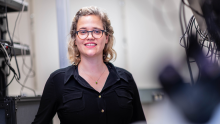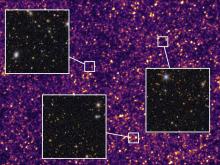Astronomers from across Canada and around the world converge on UBC to share the latest cosmic discoveries.
What are the best candidate worlds to find a real-life ET? How are cosmologists revising the latest biography of the entire Universe – past, present and future? How do some astronomers act like astronomical versions of Indiana Jones to uncover secrets in 'stellar graveyards'? How can Canadian educators learn lessons from South African experiences linking African cultural traditions with modern astrophysics? Where will Einstein fail?
More than 240 astronomers from the U.S., Europe, Africa and Canada will explore these questions and more during the annual meeting of the Canadian Astronomical Society (Societé canadienne d‟astronomie) hosted by UBC Physics and Astronomy in Vancouver, Canada.
One of the world's leading cosmologists, Malcolm Longair (University of Cambridge) will deliver the Helen Sawyer Hogg Public Lecture on Cosmology: Its Tortuous History, Glorious Present and Bright Future. Researchers from NASA’s Kepler and James Webb Space Telescope missions, from European Space Agency missions, and from newly launched, made-in Canada projects, will present their latest findings.
CASCA 2013 scientific sessions are not open to the public, but the media are invited to listen to the announcements of new discoveries and presentations of plans for future observatories and instruments on Earth and in space. Scientists and students participating in the conference will be available for interviews during their time in Vancouver.
Session tip sheet for media
Kepler mission: Discovering the next Earth
Jason Rowe (SETI Institute) is a key member of the NASA Kepler mission searching for habitable worlds.
Where will Einstein fail?
Niayesh Afshordi (Perimeter Institute) is an expert in the theories of quantum gravity and cosmological physics.
Canada’s nano-satellite family gets larger
Jaymie Mathews (UBC) on the BRITE Constellation, a new fleet of Canadian nano-satellites studying the brightest stars in the night sky, stars still hiding secrets from the world's largest telescopes.
Cosmic Africa
Thebe Medupe (founding director, Astronomy Africa) is the first black researcher to be granted a PhD in astronomy in South Africa. Can Canadian educators learn lessons from South African experiences linking African cultural traditions with modern astrophysics?
Measuring the Universe with CHIME, Canada’s largest, newest radio telescope
Gary Hinshaw (UBC) on CHIME, a made-in Canada project that’s using smart science to measure the age and evolution of the universe.
The Milky Way’s stellar graveyard
Jason Kalirai (deputy project scientist, James Webb Space Telescope, successor to the Hubble) on white dwarfs and clusters.
Public events
Cosmology: Its Tortuous History, Glorious Present and Bright Future
Malcolm Longair, Cambridge
Tuesday, May 28, 7:30 pm Hebb Theatre, UBC Vancouver


